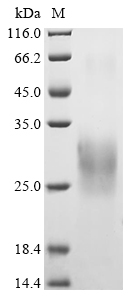Recombinant Variola virus A27L protein gets expressed in a mammalian cell system, which helps ensure proper folding and post-translational modifications. The protein covers the full length—amino acids 1 to 194—and includes an N-terminal 6xHis-Myc tag to make purification and detection simpler. SDS-PAGE analysis shows purity levels above 85%, suggesting this product should work well for different research applications.
A27L appears to be a structural component of the Variola virus. Research indicates it plays a role in mediating viral entry and cell-to-cell transmission. The protein seems to interact with other viral proteins to help with virus assembly and egress. Given its apparently critical function in the viral life cycle, A27L has become an important target for studies looking into viral pathogenesis and antiviral strategy development.
Potential Applications
Note: The applications listed below are based on what we know about this protein's biological functions, published research, and experience from experts in the field. However, we haven't fully tested all of these applications ourselves yet. We'd recommend running some preliminary tests first to make sure they work for your specific research goals.
The Variola virus A27L protein is a viral envelope protein that requires proper folding for its functional roles in heparin/heparan sulfate binding and membrane fusion. The mammalian cell expression system provides an optimal eukaryotic environment for correct folding, post-translational modifications, and disulfide bond formation. However, protein folding is a complex process that cannot be guaranteed to be 100% accurate, even in mammalian systems. The N-terminal 6xHis-Myc tag may cause minimal interference but requires experimental validation. Therefore, while the probability of correct folding is high, it must be experimentally verified before functional applications.
1. Antibody Development and Immunological Studies
Antibody development can proceed based on sequence, but conformation-specific antibodies require proper folding validation. If correctly folded (verified), this recombinant A27L is excellent for generating conformation-sensitive antibodies that recognize native epitopes, valuable for variola virus research. If misfolded/unverified, it can still produce antibodies against linear epitopes, but these may not recognize the native protein structure effectively.
2. Protein-Protein Interaction Studies
Protein-protein interactions depend on a precise tertiary structure that must be confirmed. If correctly folded (verified), this protein is highly suitable for studying physiological interactions with host receptors (e.g., heparan sulfate) or viral partners. If misfolded/unverified, interaction studies carry a high risk of non-specific binding or false negatives, providing biologically misleading data.
3. ELISA-Based Binding Assays
Immunoassays rely on sequence specificity, while functional binding requires native conformation. If correctly folded (verified), this protein is ideal for functional binding assays (e.g., heparin binding) and as a quantitative standard. If misfolded/unverified, it can serve as an immunoassay standard but will yield unreliable results in functional binding studies.
4. Biochemical Characterization Studies
This application is essential regardless of the folding state. Biochemical studies (SEC-MALS, CD spectroscopy, thermal stability) provide critical data on protein quality and directly address folding status. These studies should be performed first to determine the protein's suitability for other applications.
Final Recommendation & Action Plan
The mammalian expression system provides a high probability of correct folding for this viral protein, but experimental validation is essential before reliable use in functional studies. The immediate priority is Application 4 (Biochemical Characterization) to assess folding status through techniques like SEC-MALS and CD spectroscopy. If correct folding is verified, proceed confidently with Applications 1, 2, and 3 for antibody development, interaction studies, and functional binding assays. If misfolding is detected, limit applications to linear epitope antibody production and use as an immunoassay standard, avoiding all functional interaction studies. This systematic approach ensures appropriate application based on experimental validation of protein folding quality.






